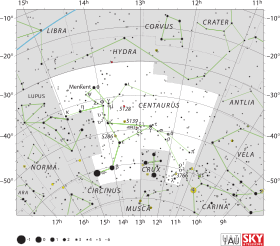A Centauri
This article is about "A Centauri". For "a Centauri", see V761 Centauri. For "α Centauri", see Alpha Centauri.

| |
| Observation data Epoch J2000.0 Equinox J2000.0 | |
|---|---|
| Constellation | Centaurus |
| Right ascension | 11h 34m 45.66s[1] |
| Declination | −54° 15′ 50.7″[1] |
| Apparent magnitude (V) | +4.62 |
| Characteristics | |
| Spectral type | B9Ve |
| U−B color index | −0.21 |
| B−V color index | −0.08 |
| Variable type | none |
| Astrometry | |
| Radial velocity (Rv) | +3 km/s |
| Proper motion (μ) | RA: -56.17 ± 0.18[1] mas/yr Dec.: 16.19 ± 0.20[1] mas/yr |
| Parallax (π) | 7.65 ± 0.22[1] mas |
| Distance | 430 ± 10 ly (131 ± 4 pc) |
| Absolute magnitude (MV) | −1.13 |
| Other designations | |
| Database references | |
| SIMBAD | data |
A Centauri (A Cen) is a star in the constellation Centaurus. It is a blue-white B-type main sequence dwarf with an apparent magnitude of +4.62 and is approximately 430 light years from Earth.
External links
- Wikisky image of HD 100673 (A Centauri)
References
- 1 2 3 4 5 van Leeuwen, F. (2007). "Validation of the new Hipparcos reduction". Astronomy and Astrophysics. 474 (2): 653–664. arXiv:0708.1752
 . Bibcode:2007A&A...474..653V. doi:10.1051/0004-6361:20078357. Vizier catalog entry
. Bibcode:2007A&A...474..653V. doi:10.1051/0004-6361:20078357. Vizier catalog entry
This article is issued from Wikipedia - version of the 3/15/2015. The text is available under the Creative Commons Attribution/Share Alike but additional terms may apply for the media files.